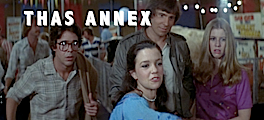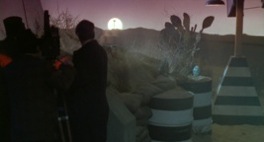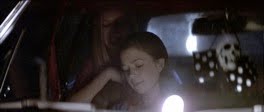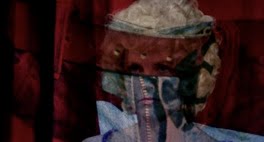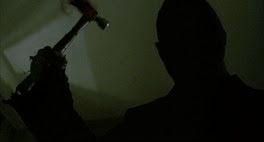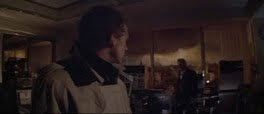The light fixture and the bouquet: two objects of fascination for Hooper, so far as I have gathered. Here, they are, by happenstance, fused, as if from the same fount of knowledge and wisdom artists go to find the items of inspiration, the foundational index of that aesthetical ultimatum "Truth is beauty, beauty truth." Where to find that highly sought after intersection between nature and civilization is in the latter's most man-made and most mimetic graces (through means of production): the harnessing of light - the dint of living through illumination - artificial or otherwise (or perhaps an atomic indeterminacy between the two), and the harnessing of nature, a bouquet an artificiality and a naturalism all at once.
Artifacts, such as clothing. Another hand-out by the passive-aggressive lover. Clothe yourself and you shall be one with our nature, our found-objects civility. Hooper's characters adorn themselves in ways that characterize them, or that beautify them - the latter, a way to return to nature, a conjoining of our modesty-artifice and our search for grace. The predominance of primary colors in Hooper's clothing, namely in The Funhouse and Poltergeist, is tied to the "bouquet of humans" he often tries to materialize.
"I'm speaking, subject."
While dressing... if Hooper's timelines weren't so compacted, he'd always have scenes of characters dressing.
"I'm listening, object." One need only think of Lisa listening to Dr. Marsh in the hospital waiting room in Spontaneous Combustion to see Hooper's similar feelings toward the disjuncture between the means of our communication - subject, object (somewhere lost: predicate) - and the idea that our communication ever resolves our battling impulses toward nature and ascendancy. Between coherency - at war with our desire to communicate in words - and false signifiers, that of language, that of self-identity... and self-assurance, that which we contrive as if natural.
The Human Bouquet
LA NATURE
"Experiment in literary investigation." The unknown, often elided inscription of a text gives away its method. An investigation through documents, texts, and primary sources. Hooper's filmography doubles as "experiments in literary investigation." That which we cannot trust - whether images or words - we must use.
LA MÉTAPHORE
La nature versus la métaphore. Granted their diversity, the concepts are one and the same, sprung from the same indexes. One is our state of being, the other the Derridean dissemblance of it into that which is unrecognizable. No concept is original, the metaphor is simply the investigation of a dissembling "nature." Imagine each of Hooper's films beginning with this red-on-white-on-black text "NATURE" and then "THE METAPHOR" before beginning its postmodernist or modernist invective and you would not be too destabilized (save, perhaps, for Texas Chainsaw 2, Spontaneous Combustion, and The Mangler: the less self-conscious melodrama and fantasy).
"In Kinshasa,"
"... at a bend in the river."
The nude woman inducts a new Africa-centric world-building, with a gesture of the hand. A nude woman inducts a new galactic-centric world-building, with a choke-hold on small men.
"Soon, everyone will need an interpreter, to understand the words coming from their own mouths."
The woman holds two roses before the man comes to her and throws the entire bouquet into her hands. Nature becomes civilization's construct before our eyes as she extols our growing ability to dissociate from ourselves, allegorized by an increasing unfamiliarity with our own language and how we deem to use it, by dint of controlling the text. Logo centrism is an illusion when the world designs to delude us, mire us in conspiracy, fool us of our own control over ourselves.
By way of the Fat Lady laughing at an unshackled Amy in The Funhouse ("Give up freedom itself," Godard will go on to announce, "and have everything returned to you"), we recall that a rose was meant to symbolize Amy in the confines of the funhouse in a mostly unrealized-within-film conception that Hooper trumpeted in a circa pre-Funhouse-release magazine interview. "Amy is the rose" that we see in the film, he said to an effect. It survives almost exclusively now in the opening credits, with the "faded gentleman" puppet holding a rose shown in conjunction with Elizabeth Berridge's credit. Her nature is singularly that which can be returned to nature (by the end of the film), an innocence that can only reach its potential by giving up all freedom. Contrast to this the freedom - of return - that the fancy thief Villamosh Anolisslovsky in The Heisters (also symbolized by a rose) only actualizes by never giving up freedom and self-interest, and thus his return is one only through death.
More dressing...
Can the image be an achievement? The lamp returns. Hooper mentions Nick Ray in the Lifeforce commentary at the very moment the camera tilts and initiates an experiment in cinematographic investigation.
Bouquets.
"Everyone can stop God from existing, but no one does."
God in the contemptful, profane prologue to Djinn.
"I remember studying the Laurent-Schwartz-Dirac curve."
"Infinite in every point except for one which is zero."
"The two greatest inventions,"
"infinity and zero."
- "No."
Infinity and zero.
Hooper's images are that image infinite at every point except that which it is zero, the limits of the frame: meaning only derived where it is null, the father at the edge of significance.
Multiple points of focus merely derive the infinity in which there is none. Sex and death imply the two limits of the image: that which gratifies, satiates, multiplies, and that which ends our search. Beauty is truth, truth is the end of purpose and the image.
Light is the closed circuit that represents our existence as a society, flickering on and off between an infinity and zero.
"Only free beings can be strangers to each other. They have shared freedom, but this is what separates them."
Hooper's filmmaking is special and especially literate, in the same way Godard's is, in that his characters are not just symbols and representations, the same way Godard's oftentimes nameless characters are not just symbols. They are everything in a relationship before they become zero. This is why every relationship in a Hooper film is an ultimatum between fulfillment and loss (and perhaps why Poltergeist does not quite feel, thematically, like a Hooper film, save for perhaps the ultimatum between a relationship bestowed with a material abundance, and then, suddenly, a relationship divested of all those things). The two filmmakers' lovers may not act and speak rationally, within the drama, but this is because the ideas are bigger than they are. They are lobbed about and volleyed to and fro by ideas, perhaps due to their namelessness, their Hooperian or Godardian ordinariness, but they are always real. Their emotions are real. They are the zero within which every point around them is infinite.
What does your husband do?
"He's just an individual." Hooper's characters do not fit into the narrative like clockwork. They are flung and rapt by the waves of narrative. Their freedom predisposes them to their fatedness, their ability to be strangers to each other and an alienation to the things around them. They share their rebellion, which is automatically lost to them, as opposed to characters, within a narratology, who conform to narrative and thus steward their fate. This is counterintuitive and paradoxical, but necessarily so.
If subjects always seem familiarized to the narrative, if they have this sort of "freedom," when in fact reality is a non-freedom, there is no image to create (without reality).
"Rodin's sculpture, The Thinker... you know it?"
Hooper literalizes the bouquet in human beings, when there are no flowers at his disposal. Godard literalizes in order to metaphorize.
With the introduction of Godard's scatological logic, we realize it is again all about human behavior and individuality, and we open it up to the world that is a dichotomy between the public and personal. We only need recall Hooper's bathroom scenes, from Eaten Alive to, yes, Crocodile, to Djinn, and we can zero in on Hooper and Godard's joint project of an "experiment in literary inertia." The world opens up at this point, and suddenly the scatological is surmisable to war.
Dressing...
Dressing, undressing. Undressing, dressing. This is such a pivotal aspect in many of Hooper's films. It shocks that a genre filmmaker can be so interested in aspects of human behavior and activity, in the nature of humans as exhibits of ontological phenomena.
"... paint not what we see, for we see nothing,
nor what we cannot see, for we must paint only what we see.
But paint that we don't see."
Undressing...
And dressing...
"... that men can be sincere with others
and even with themselves, when they glorify a woman's kindness toward
them. Although, all in all at the heart of their liaison
circulates, constantly, secretly, unavowed to others or unwittingly
revealed by questions, investigations, a painful concern. But this could
not have arisen without the previous gentleness."
At the heart of liaisons is a "painful concern." And so both Hooper and Godard constantly posit that these questions of freedom and communication are always tied to relationships. If Godard often emphasizes the typical gendered binary, decidedly non-platonic, Hooper's questions of interrelation and suffering have often branched out to mutants, children, family, property, etc. Simply, what is out there that can remove our autonomy?
"No one could think freely if his eyes were locked in another's gaze. As
soon as gazes lock, there are no longer exactly two of us."
Misery - Sadness
"What's difficult is to fit flatness into depth."
Hooper and Godard's materialism and streamlined interest in things shows a willingness to access the brash zone of inner life.
"He says he's dying."
"So let him die."

































































































































































































































































